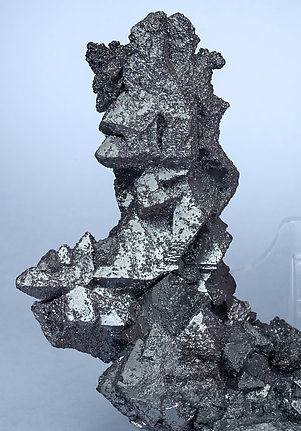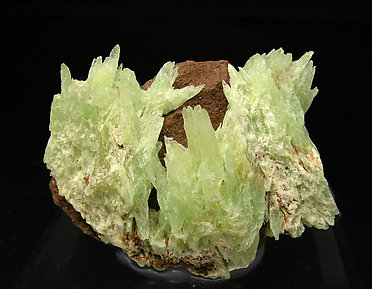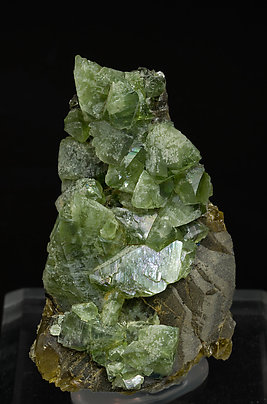

| Home page - Minerals | Friends of Minerals Forum | Minerales.info | Search |
|
| Back to the Index of the Reference Specimens |
Photos by Fabre Minerals. Under Creative Commons license
This page provides a selection of the specimens that have passed through the Fabre Minerals website and, due to their quality,
rarity, or significance as specimens from interesting locations, have been preserved as reference specimens in #MVM
| Argentina |
| Rhodochrosite stalactite | |||||||||
|---|---|---|---|---|---|---|---|---|---|
|
|
||||||||
| Rhodochrosite | |||||||||
|---|---|---|---|---|---|---|---|---|---|
|
| ||||||||
| Florencite-(Ce) with Albite, Siderite and smoky Quartz | |||||||||
|---|---|---|---|---|---|---|---|---|---|
|
|
||||||||
| Florencite-(Ce) with Quartz and Microcline | |||||||||
|---|---|---|---|---|---|---|---|---|---|
|
| ||||||||
| Fluorite with Microcline | |||||||||
|---|---|---|---|---|---|---|---|---|---|
|
|
||||||||
| Descloizite with Quartz | |||||||||
|---|---|---|---|---|---|---|---|---|---|
|
| ||||||||
| Fluorite | |||||
|---|---|---|---|---|---|
|  |
||||
| Smoky Quartz with Microcline and Albite | |||||
|---|---|---|---|---|---|
 |
| ||||
| Topaz | |||||
|---|---|---|---|---|---|
|  |
||||
| Hematite after Magnetite (variety martite) | |||||||||
|---|---|---|---|---|---|---|---|---|---|
|
| ||||||||
| Hematite after Magnetite (variety martite) | |||||||||
|---|---|---|---|---|---|---|---|---|---|
|
|
||||||||
| Hematite after Magnetite (variety martite) | |||||||||
|---|---|---|---|---|---|---|---|---|---|
|
| ||||||||
| Hematite after Magnetite (variety martite) | |||||||||
|---|---|---|---|---|---|---|---|---|---|
|
|
||||||||
| Hematite after Magnetite (variety martite) | |||||
|---|---|---|---|---|---|
 |
| ||||
| Hematite after Magnetite (variety martite) | |||||
|---|---|---|---|---|---|
|  |
||||
| Hematite after Magnetite (variety martite) | |||||||||
|---|---|---|---|---|---|---|---|---|---|
|
| ||||||||
| Hematite after Magnetite (variety martite) | ||||||||
|---|---|---|---|---|---|---|---|---|
|
|
|||||||
| Hematite after Magnetite (variety martite) | |||||||||
|---|---|---|---|---|---|---|---|---|---|
|
| ||||||||
| Hematite after Magnetite (variety martite) | |||||
|---|---|---|---|---|---|
|  |
||||
| Hematite after Magnetite (variety martite) | |||||||||
|---|---|---|---|---|---|---|---|---|---|
|
| ||||||||
| Hematite after Magnetite (variety martite) | |||||||||
|---|---|---|---|---|---|---|---|---|---|
|
|
||||||||
Argentina it is not a well know mineralogical country. An Argentinean Quartz quarry's owners carried out work searching for fine Quartz specimens to sell on the mineral market. I have an excellent relationship with him, so I purchased the best of his production. For the moment they are finding huge, doubly terminated, and frequently sceptered Amethyst Quartz. The first generation is milky white Quartz, the second generation is a deep Amethyst colored Quartz. Most of the specimens are floaters and some of them are on matrix too. Size, form and phantom inclusions are very attractive and offer to the mineral world something new that in my opinion it will help to place Argentina on the collector's map.
| Doubly terminated sceptered Quartz (variety amethyst) | |||||||||
|---|---|---|---|---|---|---|---|---|---|
|
| ||||||||
| Quartz (variety amethyst) scepter | |||||
|---|---|---|---|---|---|
|  |
||||
| Quartz (variety amethyst and scepter) | |||||
|---|---|---|---|---|---|
 |
| ||||
| Doubly terminated Quartz (variety amethyst) | |||||||||
|---|---|---|---|---|---|---|---|---|---|
|
|
||||||||
| Quartz (variety amethyst) scepter | |||||
|---|---|---|---|---|---|
 |
| ||||
| Quartz (variety amethyst) scepter and doubly terminated | |||||||||
|---|---|---|---|---|---|---|---|---|---|
|
|
||||||||
| Quartz (variety amethyst) scepter | |||||||||
|---|---|---|---|---|---|---|---|---|---|
|
| ||||||||
| Quartz (variety amethyst) doubly terminated | |||||||||
|---|---|---|---|---|---|---|---|---|---|
|
|
||||||||
| Quartz (variety amethyst) doubly terminated | |||||||||
|---|---|---|---|---|---|---|---|---|---|
|
| ||||||||
| Quartz (variety amethyst) doubly terminated | |||||||||
|---|---|---|---|---|---|---|---|---|---|
|
|
||||||||
| Bolivia |
| Povondraite with Microcline, Magnesite and Clinoenstatite | |||||||||
|---|---|---|---|---|---|---|---|---|---|
|
| ||||||||
| Ferberite | |||||||||
|---|---|---|---|---|---|---|---|---|---|
|
|
||||||||
| Cassiterite with Quartz | |||||||||
|---|---|---|---|---|---|---|---|---|---|
|
| ||||||||
| Cassiterite with Quartz | |||||||||
|---|---|---|---|---|---|---|---|---|---|
|
|
||||||||
| Cassiterite | |||||||||
|---|---|---|---|---|---|---|---|---|---|
|
| ||||||||
| Cassiterite with Quartz and Calcite | ||||||||
|---|---|---|---|---|---|---|---|---|
|
|
|||||||
| Ferberite | |||||||||
|---|---|---|---|---|---|---|---|---|---|
|
| ||||||||
| Copper after Aragonite | |||||
|---|---|---|---|---|---|
|  |
||||
| Copper after Aragonite | |||||
|---|---|---|---|---|---|
 |
| ||||
| Copper after Aragonite | ||||||||
|---|---|---|---|---|---|---|---|---|
|
|
|||||||
| Copper after Aragonite | |||||||||
|---|---|---|---|---|---|---|---|---|---|
|
| ||||||||
| Franckeite | |||||||||
|---|---|---|---|---|---|---|---|---|---|
|
|
||||||||
| Franckeite with Zinkenite and Stannite | |||||||||
|---|---|---|---|---|---|---|---|---|---|
|
| ||||||||
| Copper after Aragonite | |||||||||
|---|---|---|---|---|---|---|---|---|---|
|
|
||||||||
| Andorite | |||||||||
|---|---|---|---|---|---|---|---|---|---|
|
| ||||||||
| Andorite | |||||||||
|---|---|---|---|---|---|---|---|---|---|
|
|
||||||||
| Andorite with Cervantite | |||||||||
|---|---|---|---|---|---|---|---|---|---|
|
| ||||||||
| Andorite | |||||||||
|---|---|---|---|---|---|---|---|---|---|
|
|
||||||||
| Andorite with Pyrite and Zinkenite | |||||||||
|---|---|---|---|---|---|---|---|---|---|
|
| ||||||||
| Andorite with Zinkenite | |||||
|---|---|---|---|---|---|
|  |
||||
| Ferrokesterite with Andorite on Pyrite | |||||||||
|---|---|---|---|---|---|---|---|---|---|
|
| ||||||||
| Franckeite | |||||||||
|---|---|---|---|---|---|---|---|---|---|
|
|
||||||||
| Franckeite with Quartz and Pyrite | |||||||||
|---|---|---|---|---|---|---|---|---|---|
|
| ||||||||
| Metastibnite | |||||||||
|---|---|---|---|---|---|---|---|---|---|
|
|
||||||||
| Valentinite | |||||||||
|---|---|---|---|---|---|---|---|---|---|
|
| ||||||||
| Zinkenite | ||||||||
|---|---|---|---|---|---|---|---|---|
|
|
|||||||
| Cassiterite | |||||
|---|---|---|---|---|---|
 |
| ||||
| Ludlamite with Siderite | |||||||||
|---|---|---|---|---|---|---|---|---|---|
|
|
||||||||
| Ludlamite | |||||
|---|---|---|---|---|---|
 |
| ||||
| Vivianite | |||||||||
|---|---|---|---|---|---|---|---|---|---|
|
|
||||||||
| Cylindrite | |||||
|---|---|---|---|---|---|
 |
| ||||
| Cylindrite | |||||||||
|---|---|---|---|---|---|---|---|---|---|
|
|
||||||||
| Phosphophyllite | |||||
|---|---|---|---|---|---|
 |
| ||||
| Phosphophyllite | |||||
|---|---|---|---|---|---|
|  |
||||
| Phosphophyllite | |||||
|---|---|---|---|---|---|
 |
| ||||
| Valentinite | |||||||||
|---|---|---|---|---|---|---|---|---|---|
|
|
||||||||
| Ludlamite with Siderite and Pyrite | |||||
|---|---|---|---|---|---|
 |
| ||||
| Quartz (japan law twin) | |||||||||
|---|---|---|---|---|---|---|---|---|---|
|
|
||||||||
| Siderite with Calcite and Sphalerite | |||||||||
|---|---|---|---|---|---|---|---|---|---|
|
| ||||||||
| Wurtzite with Quartz and Fluorapatite | |||||||||
|---|---|---|---|---|---|---|---|---|---|
|
|
||||||||
| Vauxite | |||||
|---|---|---|---|---|---|
 |
| ||||
| Paravauxite | ||||||||
|---|---|---|---|---|---|---|---|---|
|
|
|||||||
| Freibergite with Quartz and Pyrite | |||||||||
|---|---|---|---|---|---|---|---|---|---|
|
| ||||||||

| Previous Page |
||||||||||||||||||||||||||||||||||||||||||||
|
||||||||||||||||||||||||||||||||||||||||||||
|
||||||||||||||||||||||||||||||||||||||||||||
|
||||||||||||||||||||||||||||||||||||||||||||